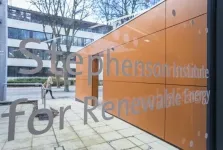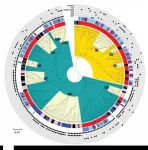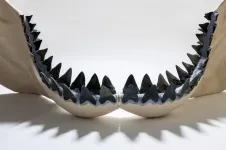(Press-News.org) COLUMBUS, Ohio - Researchers have discovered a new electronic property at the frontier between the thermal and quantum sciences in a specially engineered metal alloy - and in the process identified a promising material for future devices that could turn heat on and off with the application of a magnetic "switch."
In this material, electrons, which have a mass in vacuum and in most other materials, move like massless photons or light - an unexpected behavior, but a phenomenon theoretically predicted to exist here. The alloy was engineered with the elements bismuth and antimony at precise ranges based on foundational theory.
Under the influence of an external magnetic field, the researchers found, these oddly behaving electrons manipulate heat in ways not seen under normal conditions. On both the hot and cold sides of the material, some of the electrons generate heat, or energy, while others absorb energy, effectively turning the material into an energy pump. The result: a 300% increase in its thermal conductivity.
Take the magnet away, and the mechanism is turned off.
"The generation and absorption form the anomaly," said study senior author Joseph Heremans, professor of mechanical and aerospace engineering and Ohio Eminent Scholar in Nanotechnology at The Ohio State University. "The heat disappears and reappears elsewhere - it is like teleportation. It only happens under very specific circumstances predicted by quantum theory."
This property, and the simplicity of controlling it with a magnet, makes the material a desirable candidate as a heat switch with no moving parts, similar to a transistor that switches electrical currents or a faucet that switches water, that could cool computers or increase the efficiency of solar-thermal power plants.
"Solid-state heat switches without moving parts are extremely desirable, but they don't exist," Heremans said. "This is one of the possible mechanisms that would lead to one."
The research is published today (June 7, 2021) in the journal Nature Materials.
The bismuth-antimony alloy is among a class of quantum materials called Weyl semimetals - whose electrons don't behave as expected. They are characterized by properties that include negatively and positively charged particles, electrons and holes, respectively, that behave as "massless" particles. Also part of a group called topological materials, their electrons react as if the material contains internal magnetic fields that enable the establishment of new pathways along which those particles move.
In physics, an anomaly - the electrons' generation and absorption of heat discovered in this study - refers to certain symmetries that are present in the classical world but are broken in the quantum world, said study co-author Nandini Trivedi, professor of physics at Ohio State.
Bismuth alloys and other similar materials also feature classical conduction like most metals, by which vibrating atoms in a crystal lattice and the movement of electrons carry heat. Trivedi described the new pathway along which light-like electrons manipulate heat among themselves as a highway that seems to appear out of nowhere.
"Imagine if you were living in a small town that had tiny roads, and suddenly there's a highway that opens up," she said. "This particular pathway only opens up if you apply a thermal gradient in one direction and a magnetic field in the same direction. So you can easily close the highway by putting the magnetic field in a perpendicular direction.
"No such highways exist in ordinary metals."
When a metal like copper is heated and electrons flow from the hot end to the cold end, both the heat and the charge move together. Because of the way this highway opens in the experimental Weyl semimetal material, there's no net charge motion - only energy movement. The absorption of heat by certain electrons represents a break in chirality, or directionality, meaning that it's possible to pump energy between two particles that wouldn't be expected to interact - another characteristic of Weyl semimetals.
The theoretical physicists and engineers collaborating on this study predicted that these properties existed in specific bismuth alloys and other topological materials. For these experiments, the scientists constructed the specialized alloy to test their predictions.
"We worked hard to synthesize the correct material, which was designed from the ground up by us to show this effect. It was important to purify it way below the levels of impurities that you find in nature," Heremans said. As composed, the alloy minimized background conduction so the researchers could detect the behavior of the massless electrons, known as Weyl Fermions.
"In ordinary materials, electrons drag around with them a small magnet. However, the peculiar electronic structure of these bismuth alloys means the electrons drag around a magnet almost 50 times bigger than normal," said Michael Flatté, professor of physics and astronomy at the University of Iowa and a study co-author. "These huge subatomic magnets allowed the novel electronic state to be formed using laboratory magnetic fields.
"These results show that theories developed for high-energy physics and subatomic particle theories can often be realized in specially designed electronic materials."
Like everything quantum, Heremans said, "what we observed looks a little like magic, but that is what our equations say it should do and that is what we proved experimentally that it does."
One catch: The mechanism in this material works only at a low temperature, below minus 100 degrees Fahrenheit. With the fundamentals now understood, the researchers have lots of options as they work toward potential applications.
"Now we know what materials to look for and what purity we need," Heremans said. "That is how we get from discovery of a physical phenomenon to an engineering material."
INFORMATION:
This work was supported by Ohio State's Center for Emergent Materials, which is a National Science Foundation Materials Research Science and Engineering Center.
Additional co-authors include Dung Vu and Wenjuan Zhang of Ohio State and Cüneyt ?ahin of the University of Iowa. Flatté and ?ahin were also affiliated with the University of Chicago at the time this work was done.
Contacts:
Joseph Heremans, heremans.1@osu.edu
Nandini Trivedi, trivedi.15@osu.edu
Michael Flatté, michael-flatte@uiowa.edu
Written by Emily Caldwell, Caldwell.151@osu.edu
Carbon dioxide emissions in Los Angeles fell 33% in April of 2020 compared with previous years, as roads emptied and economic activity slowed due to the COVID-19 pandemic, according to a new study in Geophysical Research Letters. In the Washington, D.C./Baltimore region, emissions of carbon dioxide, or CO2, dropped by 34% during the same period.
The study was led by scientists at NASA's Jet Propulsion Laboratory (JPL), the National Institute of Standards and Technology (NIST) and the University of Notre Dame.
While the emissions reductions are significant, the method that scientists used to measure them may have the greater long-term impact.
In both locations, scientists had previously ...
Research between the University of Liverpool, UK and National Tsing Hua University (NTHU), Taiwan has revealed a new charge storage mechanism that has the potential to allow rechargeability within calcium-air batteries.
In a paper published in the journal Chemical Science, Professor Laurence Hardwick from the University of Liverpool's Stephenson Institute for Renewable Energy (SIRE) and colleagues discover a distinctive form of charge storage at the electrode interface described as trapped interfacial redox. This new finding introduces a new mechanism of charge storage that could be harnessed in practical devices.
Lead author of the paper, Yi Ting (Leo) Lu, is a joint PhD student in ...
A new study at the University of Chicago has determined that restoring a single microbial species -- Bacteroides sp. CL1-UC (Bc) -- to the gut microbiome at a key developmental timepoint can prevent antibiotic-induced colitis in a mouse model of the condition. The results, published on June 7 in END ...
TROY, N.Y. -- More strategic and coordinated travel restrictions likely could have reduced the spread of COVID-19 in the early stages of the pandemic. That's according to new research published in Communications Physics. This finding stems from new modeling conducted by a multidisciplinary team of scientists and engineers at Rensselaer Polytechnic Institute.
The researchers evaluated the distance between countries in terms of air travel, a more complex measurement than simply mapping physical distance. For instance, while China and Thailand may be geographically more proximate to one another, if there are significantly ...
In young women, Staphylococcus saprophyticus is a main cause of urinary tract infections (UTI), reaching 20% prevalence. Understanding the epidemiology of this microorganism can help identify its origin, distribution, causes, and risk factors. Now, ITQB NOVA researchers led by Maria Miragaia showed evidence that Staphylococcus saprophyticus can originate in food, namely in the meat-production chain.
Europe is the world's second-biggest producer of pork, the most favored meat type in these countries. One of the contaminants of that meat is S. saprophyticus, which is found also in the environment, ...
BOSTON - Current guidelines recommend stopping cervical cancer screening at age 65, but women over age 65 make up over one in five new cervical cancer diagnoses, and are twice as likely to die after a cervical cancer diagnosis compared to younger women. New research from Boston Medical Center found that fewer than one in three women aged 64 to 66 met the criteria to discontinue cervical cancer screening while looking at patients with both private insurance and from a safety-net hospital setting. Published in Gynecologic Oncology, researchers found that even among women with 10 years of continuous insurance coverage, ...
GAINESVILLE, Fla. --- A more reliable way of estimating the size of megalodon shows the extinct shark may have been bigger than previously thought, measuring up to 65 feet, nearly the length of two school buses. Earlier studies had ball-parked the massive predator at about 50 to 60 feet long.
The revised estimate is the result of new equations based on the width of megalodon's teeth - and began with a high school lesson that went awry.
Victor Perez, then a doctoral student at the Florida Museum of Natural History, was guiding students through a math ...
PHILADELPHIA (June 7, 2021) - An article written almost 30 years ago helps frame social constructs around the COVID-19 pandemic. By reviewing the essay, an historian of nursing at the University of Pennsylvania School of Nursing (Penn Nursing) extends that construct to include nurses and patients, delivering a local and personal meaning to the epidemic experience.
In an essay in the Bulletin of the History of Medicine, Julie A. Fairman, PhD, RN, FAAN, Endowed Chair, the Nightingale Professor in Honor of Nursing Veterans, and Professor of Nursing at Penn Nursing, reviews Charles Rosenberg's 1992 article about the AIDS epidemic. Using Rosenberg's theme, she further develops the ...
Metal halide perovskites have been under intense investigation over the last decade due to the remarkable rise in their performance in optoelectronic devices such as solar cells or light-emitting diodes. Despite tremendous progress in this field, many fundamental aspects of the photophysics of perovskite materials remain unknown, such as a detailed understanding of their defect physics and charge recombination mechanisms. These are typically studied by measuring the photoluminescence - i.e. the emission of light upon photoexcitation - of the material in both the steady-state and transient regimes. ...
Rockville, Md. (June 7, 2021) - Healthy habits are particularly important during pregnancy. Four new studies being presented at NUTRITION 2021 LIVE ONLINE look at how supplements, eating habits and physical activity can affect various aspects of health during pregnancy.
Prenatal supplements might influence bacterial composition of breast milk
Breast milk contains a unique mix of bacteria - known as its microbiota - that plays an important role in child health. In a new study, researchers from Purdue University examined whether diet or supplements taken prenatally affected the microbiota of breast milk in 771 mothers participating in the CHILD Cohort Study. The analysis revealed that supplements, but not dietary patterns, were linked with changes in human milk microbiota ...





